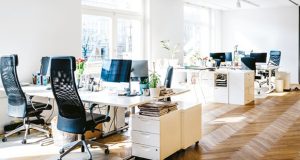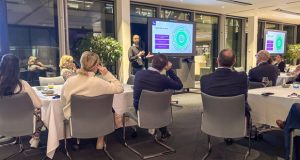Eve Fitzhenry, Head of Marketing at Boss Design, explains why quiet space free of distractions is an essential component of modern workplace layouts
If you ask office workers what they find most irritating and unproductive about their workplace, they are likely to suggest office noise and distractions. This issue has intensified over recent years for several reasons. Not only has the proliferation of mobile devices grown, the amount of space allocated to each person has fallen substantially as companies adopt more space-intensive and agile workplace models. In short, we are making more noise than ever before – and we’re closer together while doing it.
In addition, as collaboration continues to drive workplace design and as offices trend towards more open and flexible environments, the lack of private spaces for employees to concentrate and focus is now an issue. So much so that a recent comprehensive study published by Oxford Economics and Plantronics showed that three-quarters of employees said they need to take walks outside, while 32 per cent listen to headphones in order to focus and block out distractions. Meanwhile, employees in the noisiest office environments are more likely to swap their job for a working culture that offers fewer distractions.
It’s not all about noise, however. Cramped office space in which employees have no personal space or control, and open-plan offices that offer little privacy, can seriously compromise individual focused work. Furthermore, open windows, lack of meeting space, chatty co-workers, and the proliferation of mobile devices in general, only serve to exacerbate the problem.
The statistics are shocking. According to one of the latest major studies into this issue, carried out by researchers at the University of California, a typical office worker is interrupted as often as every three minutes. To make matters worse, it can take us up to 23 minutes to be able to return to the task at hand. All of this serves to increase stress levels and decrease job satisfaction. There’s a storm brewing.
Interestingly, a study of 11,000 workers carried out by office design firm Unispace found that 60 per cent of an average working day is devoted to individual task-focused work, 25 per cent to collaboration, seven per cent to socialising and around the same for learning. As well as restricting productivity and creativity, office noise and distractions can have a serious impact on employee wellbeing and motivation. It’s reported that ‘irrelevant noise’ not only disrupts work, but also increases stress levels and decreases job satisfaction. Studies confirm that 63 per cent of employees say that they lack quiet space for focused work and that this has a negative effect on their productivity, satisfaction and wellbeing.
Also, within any office environment there are differing personality types, with everybody striving for an optimal level of stimulation to be at their happiest and most productive. Unfortunately, that optimal level varies widely, and can have a profound effect on workplace design. For example, office design that creates ‘buzzy’ environments and pushes for stimulation and proximity can be overwhelming for introverts.
What’s also interesting is that extroverts tend to spend less time in the office, and when they are in the office, they tend to be in meetings. So, you could say we appear to be designing our workplaces for the people who are not actually present.
It’s tempting to think that the core problem we must address is the amount of noise in the workplace. Of course, by introducing acoustic pods, screens and quiet rooms, we can reduce noise to an extent. Flexible work schedules, remote working options and time management training are also tools to aid productivity and reduce office distractions. However, by far the most effective solution is one that addresses all of the senses, not just the ears.
The ‘collaborative habitat’ remains a key part of workplace design, assisting in the speed of idea development and knowledge flow throughout an organisation. Spaces where teams can concentrate or engage in confidential collaboration are pivotal to successful design, as are breakout spaces that encourage interaction and spontaneous conversation, as well as providing an opportunity to take a break from desk seating.
However, research shows that we still need to be able to complete distraction-free solo work in order to feel productive. According to a survey of 90,000 people by architects Gensler, ‘workplace effectiveness is not collaboration, it’s individual focus work.’ Conversely, the report also concludes that ‘focus is also the workplace environment’s least effectively supported activity.’
 CREATING HABITATS
CREATING HABITATS
As more and more companies come around to the idea of creating ‘habitats’ in the workplace to support different types of activity-based working, the challenge for office designers is to create an environment that addresses the needs of workers in all of their daily tasks, while at the same time ensuring they are engaged, happy and productive. This means creating environments with a range of settings that allow people to find the right space in which to work, whatever their psychological, physical, personality, or practical needs.
This model, which is routinely described as ‘activity based’ or ‘agile working’, is certainly not new and dates back to the time of the combi-office – a mix of cellular and open plan that was a common feature of European offices long before we even knew what a laptop was. However, the key difference nowadays is that while the combi-office was frequently specified as part of a hierarchical vision of work, today’s organisations prefer to focus on the democratic benefits of agile working.




